11-Fungi(生物信息学国外教程2010版)
红树植物桐花树内生真菌Talaromyces_amestolkiae_30的次生代谢产物

第 63 卷第 2 期2024 年 3 月Vol.63 No.2Mar.2024中山大学学报(自然科学版)(中英文)ACTA SCIENTIARUM NATURALIUM UNIVERSITATIS SUNYATSENI红树植物桐花树内生真菌Talaromyces amestolkiae 30的次生代谢产物*刘洪亮1,赵飞1,唐凤婷1,李锦俊1,张轩1,杜志云1,黄华容1,佘志刚21. 广东工业大学生物医药学院,广东广州 5100062. 中山大学化学学院,广东广州 510006摘要:对红树植物桐花树内生真菌Talaromyces amestolkiae 30的次级代谢产物进行了研究。
采用大米固体发酵培养,色谱分离技术纯化单体,ESIMS和NMR等波谱数据分析,鉴定了12个异香豆素单体化合物:aspergillumarin A(1)、aspergillumarin B(2)、 5,6-dihydroxy-3-(4-hydroxypentyl)-isochroman-1-one(3)、 mucoriso‐coumarin A(4)、 peniisocoumarin H(5)、 peniisocoumarin E(6)、 dichlorodiaportin(7)、 mucorisocoumarin C(8)、 peniiso‐coumarin G(9)、 talumarin A(10)、 5,6,8-trihydroxy-4-(1'-hydroxyethyl)-isocoumarin(11)和sescandelin(12),其中化合物4、6、7首次从篮状属真菌中分离得到。
二倍稀释法抑菌活性测试显示,化合物4、6、7有抑制金黄色葡萄球菌作用;MTT法测试细胞毒活性,表明化合物7对前列腺癌PC-3细胞和VCaP细胞有细胞毒活性。
关键词:红树林真菌;篮状菌;次级代谢产物;异香豆素类中图分类号:O629.9 文献标志码:A 文章编号:2097 - 0137(2024)02 - 0160 - 08The metabolites from mangrove endophytic fungus Talaromyces amestolkiae30LIU Hongliang1, ZHAO Fei1, TANG Fengting1, LI Jinjun1,ZHANG Xuan1, DU Zhiyun1, HUANG Huarong1, SHE Zhigang21. School of Biomedicine, Guangdong University of Technology, Guangzhou 510006, China2. School of Chemistry, Sun Yat-sen University, Guangzhou 510006, ChinaAbstract:The metabolites of the endophytic fungus Talaromyces amestolkiae30 from the mangrove plant Aegiceras corniculatum (L.) Blanco were investigated. The fungus was cultured in rice medium, the monomeric compounds were isolated and purified by the chromatographic technique, and the structures of the compounds were identified by analysis of spectroscopy such as ESIMS and NMR.Twelve known analogues of isocoumarins (1-12) were isolated and identified as aspergillumarin A (1), aspergillumarin B (2), 5,6-dihydroxy-3-(4-hydroxypentyl)-isochroman-1-one (3), mucorisocoumarin A(4), peniisocoumarin H (5), peniisocoumarin E (6), dichlorodiaportin (7), mucorisocoumarin C (8), peni‐isocoumarin G (9), talumarin A (10), 5,6,8-trihydroxy-4-(1'-hydroxyethyl)-isocoumarin (11) and sescan‐delin (12). Among them, compounds 4, 6 and 7 were obtained from the genus Talaromyces for the first time. The antibacterial activities of these compounds were tested in vitro using the twofold dilution method. Compounds 4, 6, and 7 showed inhibitory activity against Staphylococcus aureus. The cytotoxic activity was tested by the MTT assay. Compound 7 showed cytotoxicity against prostate cancer PC-3DOI:10.13471/ki.acta.snus.2023E048*收稿日期:2023 − 10 − 14 录用日期:2023 − 11 − 30 网络首发日期:2024 − 01 − 08基金项目:广东省海洋经济发展(海洋六大产业)专项资金(粤自然资合[2021]48号)作者简介:刘洪亮(1996年生),男;研究方向:制药工程;E-mail:*********************通信作者:黄华容(1978年生),女;研究方向:天然药物化学;E-mail:****************.cn第 2 期刘洪亮,等:红树植物桐花树内生真菌Talaromyces amestolkiae 30的次生代谢产物cells and VCaP cells.Key words : mangrove fungus ; Talaromyces amestolkiae ; secondary metabolites ; isocoumarin 异香豆素是一类重要的天然产物,广泛存在于自然界中,其种类繁多(Saddiqa et al.,2017; Reveglia et al.,2020;Shabir et al.,2021;Aierken et al.,2023)。
《微生物学》双语教学
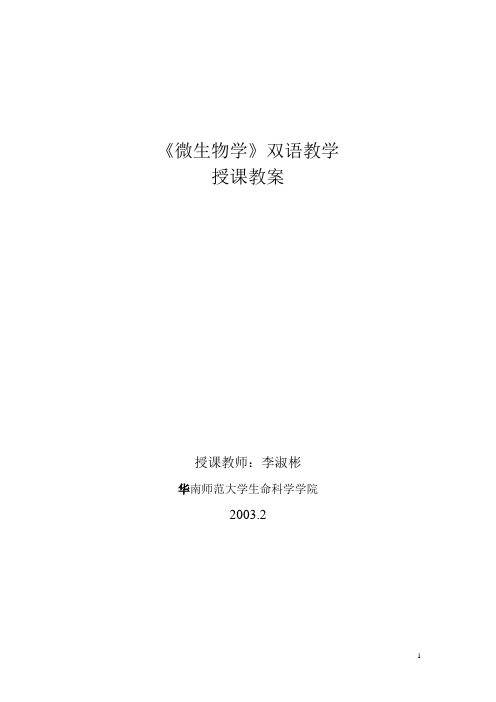
《微生物学》双语教学授课教案授课教师:李淑彬华南师范大学生命科学学院2003.2Chapter1 The introduction of microbiology第1 章绪论Microbiology(微生物学):Microbiology is specialized area of biology that deals with living things ordinarily too small to be seen with the naked eyes.Microorganisms(微生物,microbe):Microorganisms are defined as the organisms that are so small that ,normally,it cannot be seen without the use of a mocriscope.The word is therefore used to describe virus,bacreria,fungi,protozoom and some algae.Bacteria(细菌) :Bacteria are some small,single celle organisms. Because they have no nucleus, the cells are described as prokaryotes.Fungi(真菌):Fungi (mushrooms(蘑菇), molds(霉菌), and yeasts) have eukaryotic(真核的)cells (with a true nucleus). Most fungi are multicellular.Fungi obtain nutrients by absorbing organic material from their environment.Protozoom(原生动物):Protozoans are unicellular eucaryotes and are classified according to their means of locomotion. Protozoans obtain nourishment by absorption or ingestion through specialized structures.Algae(藻类):Alage are unicellular or multicellular eukaryotes that obtain nourishment by photosynthesis.Algae produce oxygen and carbohydrates that are used by other organisms.Viruses(病毒):Viruses are noncellular entities that are parasites of cells. Viruses consist of a nucleic acid core (DNA or RNA) surrounded by a protein coat. An envelope may surround the coat.A brief history of microbiologyThe science of microbiology did not start until the invention of the microscope in the mid 16th century and it was not until the late 17th century that Antoine van Leeuwenhoek made their first records of fungi, bacteria and protozoa.The late 19th century was the time when the first real breakthroughs on the role of microbes in the environment and medicine were made. Louis Pasteur disproved the theory of spontaneous generation(自然发生)(that living organisms spontaneously arose from inorganic material) and Robert Koch's development of pure culture techniques allowed him to show unequivocally that a bacterium was responsible for a particular disease. Since then the science has grown dramatically as microbiology impinges on all aspects of life and the environment.2.Louis Pasteur stated that microorganisms are in the air everywhere and offered proof ofbiogenesisLouis Pasteurˊdiscoveries led to the developmemt of aseptic(无菌的)techniques used in laboratory and medical procedures to prevent contamination by microorangisms that are in the air.Louis Pasteur found that yeast ferments(发酵)sugar to alchhol and that can oxidize alcohol to acetic acid.A heating process called pasteurization(巴斯德消毒)is used to kill bacteria in some alcohol beverages and milks.Joseph Lister introduced the use of a disinfectant(消毒)to clean surgical dressings in order to control infections in humans.Robert Koch proved that microorganisms transmit diseases.He used a sequence of procedures called Koch’s postulates(科赫法则),Which areused today to prove that a particular microorganism casues a particular disease.Koch’s postulates:Koch's postulates are a number of criteria that have been used in the past to prove that a bacterium is responsible for a particular disease.1.The bacteria should be found in all cases and at all sites of the disease.2.The bacteria should be isolated from the infected person and maintained in pure culture.3.The pure cultured microbe should cause symptoms of the disease on inoculation into asusceptible individual.4.The bacteria should be reisolated from the intentionally infected host.The importance of microbiology:microbes in our body1.Everyone has microorganisms in and on the body Some microorganisms live in humans andother animals and are needed to maintain the animals health. these make up the normal flora (正常菌群);2.Some Microorganisms cause disease.3.The disease-producing properties of a species of microbe and the host's resistance areimportant factors in determining whether a person will contract a disease.2.Microbes and Human Welfare1.Microorganisms degrade dead plants and animals and recycle chemical elements to beused by living plants and animals.2.Bacteria are used to decompose organic matter in sewage. Bioremediation processes usebacteria to clean up toxic wastes.3.Bacteria that cause diseases in insects are being used as biological controls of insect pests.Biological controls are specific for the pest and do not harm the environment.ing recombinant DNA, bacteria can produce important human proteins, such as insulin,beta-endorphin,and hepatitis B vaccine.Microorganisms can be used to help produce foods.They are also food sources (single-cell protein) themselves.3.As a basic biological science:microorganisms are the best model systems for understanding basic life processes.All cells have much in common, what is true for E. coli is also true for elephant, only more soSimple yet representativeEasiness and quickness to grow large quantityCommon characterizes of microorganism•Big surface/volume•High absorption and transformation•Rapid growth and reproduction•Easiness to variation•high adaptation to environment•DiversityReview question1.Match the following people to their contribution toward the advancement of microbiology.__ Ehrlich (a) First to observe bacteria__ Fleming (b) First to observe cells in__ Hooke plant material and name_ Koch them__ Lister (c) Disproved spontaneous__ Pasteur generation__ Van Leeuwenhoek (d) Proved that microorganisms can cause disease(e)Discovered penicillin(f)Used the first syntheticchemotheraputic agent First to employdisinfectants in surgical procedures2. Match the following microorganisms to their descriptions.__ Algae (a) Not composed of cells__ Bacteria (b) Cell wall made of chitin__ Fungi (c) Cell wall made of__ Protozoom peptidoglycan__ Viruses (d) Cell wall made of cellulose; photosynthetic(e) Complex cell structure lacking a cell wall3.Briefly state the role played by microorganisms in each of the following.(a)Biological control of pests(b)Recycling of elements(c)Normal flora(d)Sewage treatment(e)Human insulin production4 The microbes were first formally observed in the mid-1600's, but the cell theory wasn't enunciated until 1839. Write a brief essay explaining why microbiology did not become a formally recognized science until Pasteur's time.5. Compare and contrast the works of Louis Pasteur and Robert Koch, in terms of both applied and basic science.6. Microorganisms can be both beneficial and harmful to humans. Although we tend to emphasize the harmful microorganisms (infectious disease agents), many more are beneficial than harmful.●In what ways are microorganisms important in the food , agriculture,and industries?7. Louis Pasteur´s work on spontaneous generation led to the development of methods for control of the growth of microorganisms. Robert Koch developed criteria for the study of infectious microorganisms, and developed the first methods for the growth of pure cultures of microorganisms. Beijerinck and Winogradsky studied bacteria in soil and water, and developed the enrichment culture technique. In the twentieth century, basic and applied microbiology have worked hand in hand to yield a number of important practical advances and a revolution in molecular biology.●How did Pasteur´s famous experiment defeat the theory of spontaneous generation?●How can Koch´s postulates prove cause and effect in a disease?●Who was the first person to use solid culture media in microbiology?●What advantages do so lid media offer for the culture of microorganisms?●What is the enrichment culture technique and why was it a useful new method inmicrobiology?Chapter 2 prokayotic microorganism(原核微生物)第二章原核微生物prokaryotic cellsThe chief distinguishing characteristics of procaryotic cells are:1.genetic material (DNA) is not enclosed within a membrane.2.They lack other membrane bounded organelles.3.Their DNA is not associated with histone proteins (special chromosomalproteins found in eucaryotes).Their cell walls almost always contain thecomplex polysaccharide peptidoglycan(肽聚糖).Bacteria(细菌) and archaeobacteria(古细菌)Bacteria are small, single-celled, microorganisms that belong to a group called prokaryotes . Bacteria are ubiquitous. They are a highly successful and diverse group of organisms that can obtain energy and carbon from a wide range of sources and therefore can colonize every niche on our planet from deep ocean trenches to volcanic craters. In the 1970s, using DNA sequencing information, it was found that the group we know as the bacteria could be split into two, the eubacteria and the archaeobacteria and it appears that these two groups evolved away from each other very early in the history of living things at about the same time that the first group of eukaryotic cells evolved. Members of the eubacteria include some of the more familiar bacteria such as Escherichia colt(大肠埃希氏菌)and Staphylococcus aureus(金黄色葡萄球菌)and are the prokaryotes that are best studied and understood. The archaebacteria are a very diverse group of organisms, which differ from the eubacteria(真细菌0 in a number of features having, in particular, very different cell walls and membranes. This group includes bacteria that are capable of existing in extreme environments。
03-BLAST(生物信息学国外教程2010版)
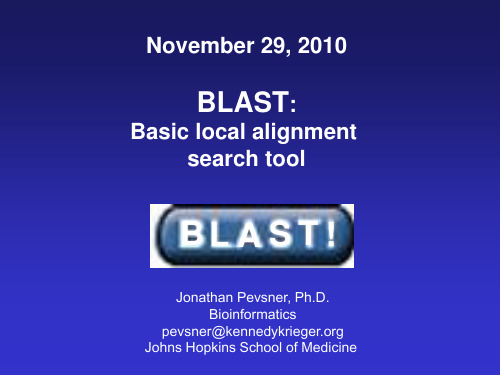
BLAST search output: top portion
database query
program
taxonomy
page 112
BLAST search output: taxonomy report summarizes species with matches
BLAST search output: graphical output
page 112
BLAST search output: tabular output
High scores low E values
Cut-off: .05? 10-10?
page 113
BLAST search output: alignment output
Outline of today’s lecture
Step 4: optional parameters
You can... • choose the organism to search • turn filtering on/off • change the substitution matrix • change the expect (e) value • change the word size • change the output format
page 109
(c) Query: human insulin NP_000198 Program: blastp Database: C. elegans RefSeq Option: conditional compositional score matrix adjustment
Note that the bit score, Expect value, and percent identity all change with the compositional score matrix adjustment
真菌生物信息学研究概况
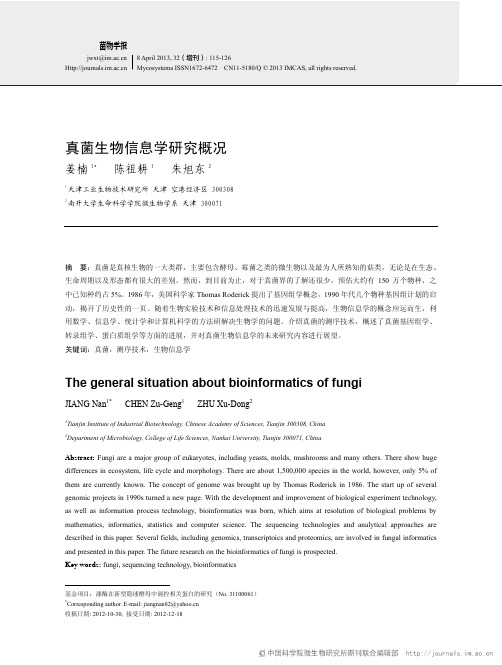
基金项目:漆酶在新型隐球酵母中调控相关蛋白的研究(No. 31100061)*Corresponding author. E-mail: jiangnan82@收稿日期: 2012-10-30, 接受日期: 2012-12-18真菌生物信息学研究概况姜楠1* 陈祖耕1 朱旭东21天津工业生物技术研究所 天津 空港经济区 300308 2南开大学生命科学学院微生物学系 天津 300071摘 要:真菌是真核生物的一大类群,主要包含酵母、霉菌之类的微生物以及最为人所熟知的菇类,无论是在生态、生命周期以及形态都有很大的差别。
然而,到目前为止,对于真菌界的了解还很少,预估大约有150万个物种,之中已知种约占5%。
1986年,美国科学家Thomas Roderick 提出了基因组学概念,1990年代几个物种基因组计划的启动,揭开了历史性的一页。
随着生物实验技术和信息处理技术的迅速发展与提高,生物信息学的概念应运而生,利用数学、信息学、统计学和计算机科学的方法研解决生物学的问题。
介绍真菌的测序技术,概述了真菌基因组学、转录组学、蛋白质组学等方面的进展,并对真菌生物信息学的未来研究内容进行展望。
关键词:真菌,测序技术,生物信息学The general situation about bioinformatics of fungiJIANG Nan 1* CHEN Zu-Geng 1 ZHU Xu-Dong 21Tianjin Institute of Industrial Biotechnology, Chinese Academy of Sciences, Tianjin 300308, China 2Department of Microbiology, College of Life Sciences, Nankai University, Tianjin 300071, ChinaAbstract: Fungi are a major group of eukaryotes, including yeasts, molds, mushrooms and many others. There show huge differences in ecosystem, life cycle and morphology. There are about 1,500,000 species in the world, however, only 5% of them are currently known. The concept of genome was brought up by Thomas Roderick in 1986. The start up of several genomic projects in 1990s turned a new page. With the development and improvement of biological experiment technology, as well as information process technology, bioinformatics was born, which aims at resolution of biological problems by mathematics, informatics, statistics and computer science. The sequencing technologies and analytical approaches are described in this paper. Several fields, including genomics, transcriptoics and proteomics, are involved in fungal informatics and presented in this paper. The future research on the bioinformatics of fungi is prospected. Key words: fungi, sequencing technology, bioinformaticsISSN1672-6472 CN11-5180/Q Mycosystema April 8, 2013 V ol.32 (Suppl.)/jwxtcn116 1 真菌测序策略及其应用1.1 第一代测序技术早在1954年,Whitfeld (1954)就报道用化学降解的方法测定多聚核糖核苷酸序列。
《生物信息学》2010年总目次
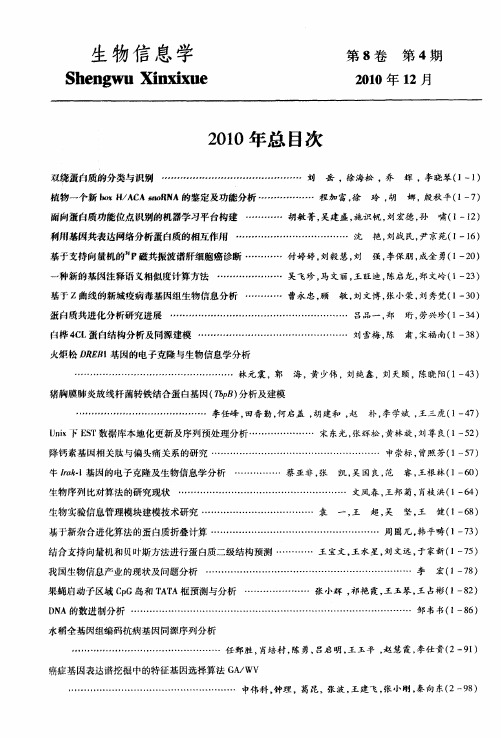
蛋白质共进 化分析研究进 展 …… …………… ………… ……… …………… 吕品一 , 郑
自桦 4 L餐 白结构 分析及 同源建模 … ……… ………… …………… ……… 刘雪梅 , C 陈 肃 , 宋福 南( — 8 1 3) 火炬 松 D E I 因的电子 克隆与生物信 息学分 析 RB 基
李任峰 , 田香 勤 , 启盖 , 何 胡建 和 , 赵
U i E T数据库本 地化更新及 序列预处理 分析 …… ………… … 宋 东光 , n x下 S 张辉松 , 林旋 , 黄 刘尊 良( — 2 1 5)
降钙素基因相关肽与偏头痛关系的研究 ……………………………………………… 申崇标, 曾照芳( — 7 1 5)
生 物 信 息 学
第8 第4 卷 期
21 0 0年 1 2月
2l OO年总 目次
双绕强自质的分类与识别 ……………………………………… 刘 岳 , 徐海松 , 乔
植物 一个新 I/C nR A的鉴定 及功能分 析 ……… ……… 程 加 富, :A Aso N L 徐 玲 , 胡
辉 , 李晓琴( — ) 1 1
拟南芥 L C同 源基 因的生物 信息 学分析 …… ……… … … 唐 静仪 , E 樊晓 霞 , 中奇 , 杨 宋晓婕 , 王万 军( 2—14 1)
拟南芥 、 水稻 和杨 树 J J M C家 族全 基 因组分析 …… ……… …… ……… … ……… … 郭 源远 , 京 苑( 尹 2一l8 1)
申伟科 , 钟理 ,葛昆,张波 , 王建飞 , 张小刚 , 秦向 东( 9 ) 2— 8
3 9 7
基 因表达 数据 聚类 分 析技术 及其 软件工 具 …… … ……… …… …… ……… …… ……… … 欧阳玉梅 ( 2—14 0) J K B— L离散量 在识 别 D A编码 区域 中 的应 用 N … …… ……… ……… … … 张景祥 , 徐振 源 , 晓兵 ( 赵 2—10 1)
01-Introduction to Bioinformatics(生物信息学国外教程2010版) PPT课件
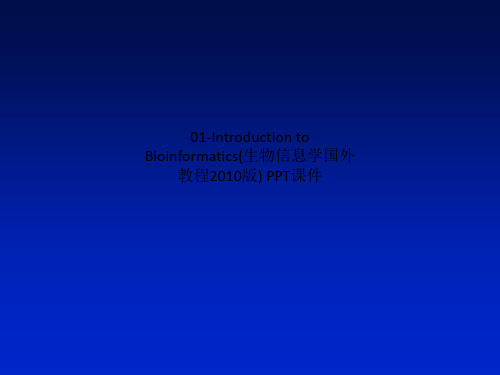
Textbook
The course textbook has no required textbook. I wrote Bioinformatics and Functional Genomics (Wiley-Blackwell, 2nd edition 2009). The lectures in this course correspond closely to chapters.
The textbook website is: This has powerpoints, URLs, etc. organized by chapter. This is most useful to find “web documents” corresponding to each chapter.
I will make pdfs of the chapters available to everyone.
You can also purchase a copy at the bookstore, at (now $60), or at Wiley with a 20% discount through the book’s website .
Literature references
You are encouraged to read original source articles (posted on moodle). They will enhance your understanding of the material. Readings are optional but recommended.
Web sites
The course website is reached via moodle: /moodle (or Google “moodle bioinformatics”) --This site contains the powerpoints for each lecture, including black & white versions for printing --The weekly quizzes are here --You can ask questions via the forum --Audio files of each lecture will be posted here
2010生物信息学
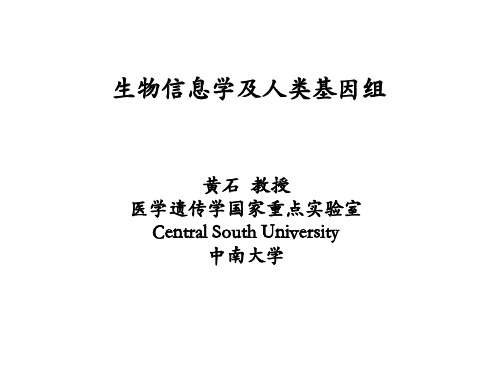
2)RNA、蛋白质高级结构和功能的预测; 3)基因组进化;建立进化树 4)物种复杂性识别
遗传距离(Genetic distance)
1 1 1 55 55 55 G DVEKGKKIFIMKCSQCHTVEKGGKHKTGPNLHGLFGRKTGQAPGYSYTAANKN 54 H s G DVEKGKKLFVQRCAQCHTVEAGGKHKVGPNLHGLIGRKTGQAAGFAYTDANKA 54 D m G SAKKGATLFKTRCLQCHTVEKGGPHKVGPNLHGIFGRHSGQAEGYSYTDANIK 54 Sc Hs Dm Sc K GIIWGEDTLMEYLENPKKYIPGTKMIFVGIKKKEERADLIAYLKKAT 1 02 Hs 22 36 K GITWNEDTLFEYLENPKKYIPGTKMIFAGLKKPNERGDLIAYLKSAT 1 02 Dm 36 K NVLWDENNMSEYLTNPKKYIPGTKMAFGGLKKEKDRNDLITYLKKAT 1 02 Sc
分子钟和中性理论要点
分子钟: 不同物种的平均每年突变速度大致相同 ,并保持恒定。
中性理论: 物种之间的遗传距离大部分是由中性 突变的随机产生造成。
分子钟和中性理论的价值
小进化范围内大致被试验证明成立, 并且直觉上 也应该在小进化范围内(并只能在该范畴内)成 立。 是分子进化及生物信息学的主要理论基础。
生物物种复杂性即表观遗传复杂性 Epigenetic Complexity
表观遗传复杂性:
个体所具有的细胞种类总数以及表观遗传相关分子总 数。表观遗传是独立于DNA序列的遗传现象。
等同的日常概念: 图纸 blueprint, achitectural plan, archetype.
昆虫共生微生物及其功能研究进展
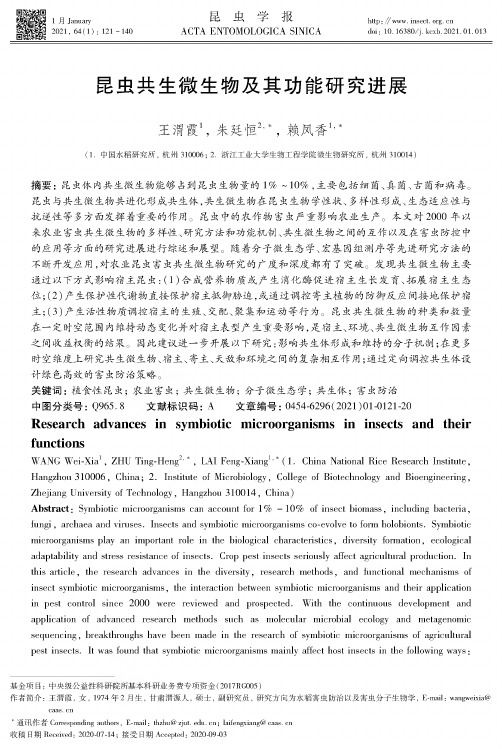
http : ! www. insect. cry. cndol : 10.16380/j. kcb.2021.01.0131 月 Januaa2021, 64(1): 121 -140昆虫学报ACTAENTOMOLOGICASINICA昆虫共生微生物及其功能研究进展王渭霞打朱廷恒2'**,赖凤香1!"基金项目:中央级公益性科研基本科研业务费专项资金(2017RG005)作者简介:王渭霞,女,1974年2月生,甘肃渭源人!硕士!副研究员!研究方向为水稻害虫防治以及害虫分子生物学! E-mail : wangeVVT* 通讯作者 Corresponding authore , E-mail : thzhu@ zjut. edu. cn % laifengxiang@ caas. cn收稿日期 Received : 2020X7X4% 接受日期 Accepted : 2020-09-F3(1.中国水稻研究所,杭州310006 %2.浙江工业大学生物工程学院微生物研究所,杭州310014)摘要:昆'体内共生微生物能够占到昆'生物量的1% -10%,主要包括细菌、真菌、古菌和病毒$ 昆'与共生微生物共进化形成共生体,共生微生物在昆'生物学性状、多样性形成、生态适应性与抗逆性等多方面发挥着重要的作用。
昆'中的农作物害'严重影响农业生产$本文对2000年以来农业害'共生微生物的多样性、研究方法和功能机制、共生微生物之间的互作以及在害'防控中 的应用等方面的研究进展进行综述和展望。
随着分子微生态学、宏基因组测序等先进研究方法的不断开发应用,对农业昆'害'共生微生物研究的广度和深度都有了突破。
发现共生微生物主要 通过以下方式影响宿主昆':(1)合成营养物质或产生消化酶促进宿主生长发育、拓展宿主生态位;(2)产生保护性代谢物直接保护宿主抵御胁迫,或通过调控寄主植物的防御反应间接地保护宿 主;(3)产生活性物质调控宿主的生殖、交配、聚集和运动等行为。
04-Multiple sequence alignment(生物信息学国外教程2010版)

Page 179
Multiple sequence alignment: outline
[1] Introduction to MSA Exact methods Progressive (ClustalW) Iterative (MUSCLE) Consistency (ProbCons) Structure-based (Expresso) Conclusions: benchmarking studies [2] Hidden Markov models (HMMs), Pfam and CDD
Multiple sequence alignment: outline
[1] Introduction to MSA Exact methods Progressive (ClustalW) Iterative (MUSCLE) Consistency (ProbCons) Structure-based (Expresso) Conclusions: benchmarking studies [2] Hidden Markov models (HMMs), Pfam and CDD
Page 185
Use ClustalW to do a progressive MSA
http://www.ebi. /clustalw/
Page 186
Feng-Doolittle MSA occurs in 3 stages
[1] Do a set of global pairwise alignments (Needleman and Wunsch’s dynamic programming algorithm) [2] Create a guide tree
This insertion could be due to alternative splicing
生物信息学复习总结
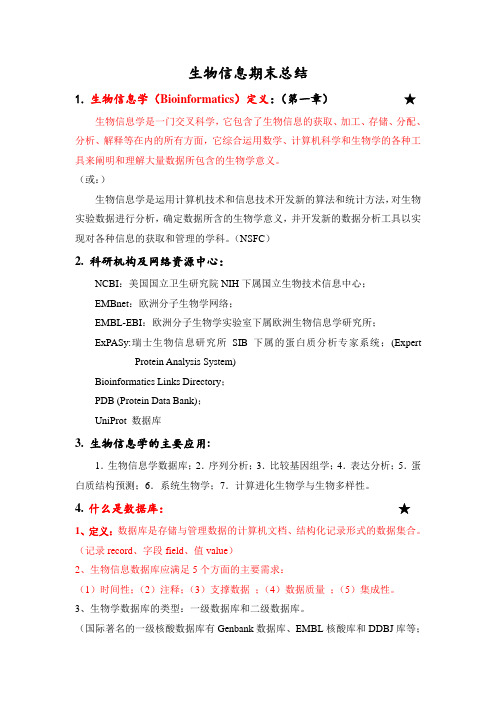
生物信息期末总结1.生物信息学(Bioinformatics)定义:(第一章)★生物信息学是一门交叉科学,它包含了生物信息的获取、加工、存储、分配、分析、解释等在内的所有方面,它综合运用数学、计算机科学和生物学的各种工具来阐明和理解大量数据所包含的生物学意义。
(或:)生物信息学是运用计算机技术和信息技术开发新的算法和统计方法,对生物实验数据进行分析,确定数据所含的生物学意义,并开发新的数据分析工具以实现对各种信息的获取和管理的学科。
(NSFC)2. 科研机构及网络资源中心:NCBI:美国国立卫生研究院NIH下属国立生物技术信息中心;EMBnet:欧洲分子生物学网络;EMBL-EBI:欧洲分子生物学实验室下属欧洲生物信息学研究所;ExPASy:瑞士生物信息研究所SIB下属的蛋白质分析专家系统;(Expert Protein Analysis System)Bioinformatics Links Directory;PDB (Protein Data Bank);UniProt 数据库3. 生物信息学的主要应用:1.生物信息学数据库;2.序列分析;3.比较基因组学;4.表达分析;5.蛋白质结构预测;6.系统生物学;7.计算进化生物学与生物多样性。
4.什么是数据库:★1、定义:数据库是存储与管理数据的计算机文档、结构化记录形式的数据集合。
(记录record、字段field、值value)2、生物信息数据库应满足5个方面的主要需求:(1)时间性;(2)注释;(3)支撑数据;(4)数据质量;(5)集成性。
3、生物学数据库的类型:一级数据库和二级数据库。
(国际著名的一级核酸数据库有Genbank数据库、EMBL核酸库和DDBJ库等;蛋白质序列数据库有SWISS-PROT等;蛋白质结构库有PDB等。
)4、一级数据库与二级数据库的区别:★1)一级数据库:包括:a.基因组数据库----来自基因组作图;b.核酸和蛋白质一级结构序列数据库;c.生物大分子(主要是蛋白质)的三维空间结构数据库,(来自X-衍射和核磁共振结构测定);2)二级数据库:是对原始生物分子数据进行整理、分类的结果,是在一级数据库、实验数据和理论分析的基础上针对特定的应用目标而建立的。
人组蛋白去乙酰化酶11的克隆表达与生物信息学分析
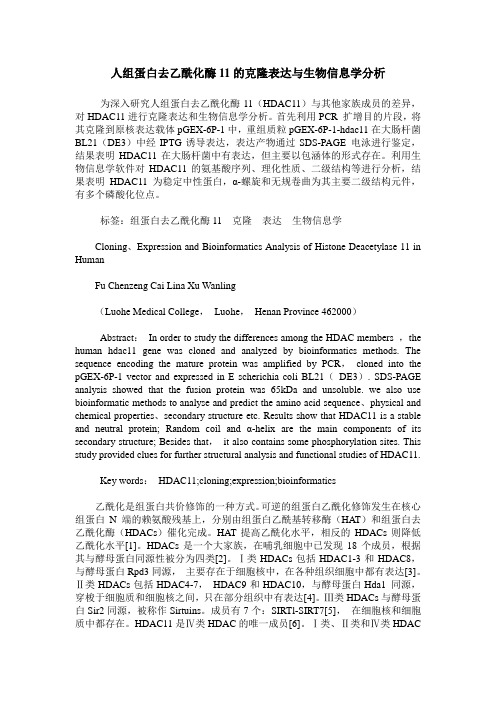
人组蛋白去乙酰化酶11的克隆表达与生物信息学分析为深入研究人组蛋白去乙酰化酶11(HDAC11)与其他家族成员的差异,对HDAC11进行克隆表达和生物信息学分析。
首先利用PCR 扩增目的片段,将其克隆到原核表达载体pGEX-6P-1中,重组质粒pGEX-6P-1-hdac11在大肠杆菌BL21(DE3)中经IPTG诱导表达,表达产物通过SDS-PAGE 电泳进行鉴定,结果表明HDAC11在大肠杆菌中有表达,但主要以包涵体的形式存在。
利用生物信息学软件对HDAC11的氨基酸序列、理化性质、二级结构等进行分析,结果表明HDAC11为稳定中性蛋白,α-螺旋和无规卷曲为其主要二级结构元件,有多个磷酸化位点。
标签:组蛋白去乙酰化酶11 克隆表达生物信息学Cloning、Expression and Bioinformatics Analysis of Histone Deacetylase 11 in HumanFu Chenzeng Cai Lina Xu Wanling(Luohe Medical College,Luohe,Henan Province 462000)Abstract:In order to study the differences among the HDAC members ,the human hdac11 gene was cloned and analyzed by bioinformatics methods. The sequence encoding the mature protein was amplified by PCR,cloned into the pGEX-6P-1 vector and expressed in E scherichia coli BL21(DE3). SDS-PAGE analysis showed that the fusion protein was 65kDa and unsoluble. we also use bioinformatic methods to analyse and predict the amino acid sequence、physical and chemical properties、secondary structure etc. Results show that HDAC11 is a stable and neutral protein; Random coil and α-helix are the main components of its secondary structure; Besides that,it also contains some phosphorylation sites. This study provided clues for further structural analysis and functional studies of HDAC11.Key words:HDAC11;cloning;expression;bioinformatics乙酰化是组蛋白共价修饰的一种方式。
09-Viral Genomics(生物信息学国外教程2010版)
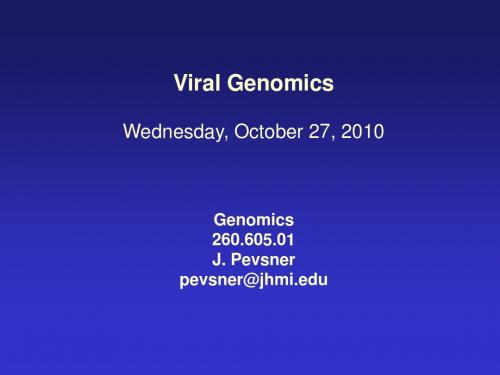
Fig. 14.1 Page 569
The International Committee on Taxonomy of Viruses (ICTV) offers a website, accessible via NCBI’s Entrez site
/ICTVdb/
Page 569
Viral metagenomics
Viral metagenomics refers to the sampling of representative viral genomes from the environment. A typical viral genome is ~50 kilobases (in comparison, a typical microbial genome is ~2.5 megabases). A sample is collected (e.g. seawater, fecal material, or soil). Cellular material is excluded. Viral DNA is extracted, cloned, and sequenced.
Page 569
Mimivirus: mimicking microbe
The mimivirus genome is 1.2 Mb (1,181,404 base pairs). It is a double-stranded DNA virus. ► Two inverted repeats of 900 base pairs at the ends (thus it may circularize) ► 72% AT content (~28% GC content) ► 1262 putative open-reading frames (ORFs) of length >100 amino acids. 911 of these are predicted to be protein-coding genes ► Unique features include genes predicted to encode proteins that function in protein translation. The inability to perform protein synthesis has been considered a prime feature of viruses, in contrast to most life forms. See Raoult D et al. (2004) Science 306:1344.
ff2011 cell Analysis of the human endognous coregulator complexome
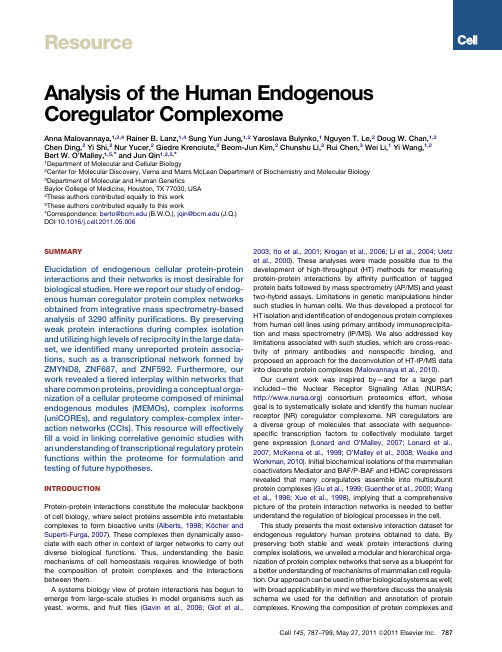
2003; Ito et al., 2001; Krogan et al., 2006; Li et al., 2004; Uetz et al., 2000). These analyses were made possible due to the development of high-throughput (HT) methods for measuring protein-protein interactions by affinity purification of tagged protein baits followed by mass spectrometry (AP/MS) and yeast two-hybrid assays. Limitations in genetic manipulations hinder such studies in human cells. We thus developed a protocol for HT isolation and identification of endogenous protein complexes from human cell lines using primary antibody immunoprecipitation and mass spectrometry (IP/MS). We also addressed key limitations associated with such studies, which are cross-reactivity of primary antibodies and nonspecific binding, and proposed an approach for the deconvolution of HT-IP/MS data into discrete protein complexes (Malovannaya et al., 2010). Our current work was inspired by—and for a large part included—the Nuclear Receptor Signaling Atlas (NURSA; ) consortium proteomics effort, whose goal is to systematically isolate and identify the human nuclear receptor (NR) coregulator complexome. NR coregulators are a diverse group of molecules that associate with sequencespecific transcription factors to collectively modulate target gene expression (Lonard and O’Malley, 2007; Lonard et al., 2007; McKenna et al., 1999; O’Malley et al., 2008; Weake and Workman, 2010). Initial biochemical isolations of the mammalian coactivators Mediator and BAF/P-BAF and HDAC corepressors revealed that many coregulators assemble into multisubunit protein complexes (Gu et al., 1999; Guenther et al., 2000; Wang et al., 1996; Xue et al., 1998), implying that a comprehensive picture of the protein interaction networks is needed to better understand the regulation of biological processes in the cell. This study presents the most extensive interaction dataset for endogenous regulatory human proteins obtained to date. By preserving both stable and weak protein interactions during complex isolations, we unveiled a modular and hierarchical organization of protein complex networks that serve as a blueprint for a better understanding of mechanisms of mammalian cell regulation. Our approach can be used in other biological systems as well; with broad applicability in mind we therefore discuss the analysis schema we used for the definition and annotation of protein complexes. Knowing the composition of protein complexes and
05-Molecular Phylogeny(生物信息学国外教程2010版)

Fig. 7.3 Page 220
Historical background: insulin
By the 1950s, it became clear that amino acid substitutions occur nonrandomly. For example, Sanger and colleagues noted that most amino acid changes in the insulin A chain are restricted to a disulfide loop region. Such differences are called “neutral” changes (Kimura, 1968; Jukes and Cantor, 1969). Subsequent studies at the DNA level showed that rate of nucleotide (and of amino acid) substitution is about sixto ten-fold higher in the C peptide, relative to the A and B chains.
To Darwin, the struggle for existence induces a natural selection. Offspring are dissimilar from their parents (that is, variability exists), and individuals that are more fit for a given environment are selected for. In this way, over long periods of time, species evolve. Groups of organisms change over time so that descendants differ structurally and functionally from their ancestors.
巴西橡胶树棒孢霉落叶病菌Slt2类MAPK同源基因CMP1的克隆与序列分析
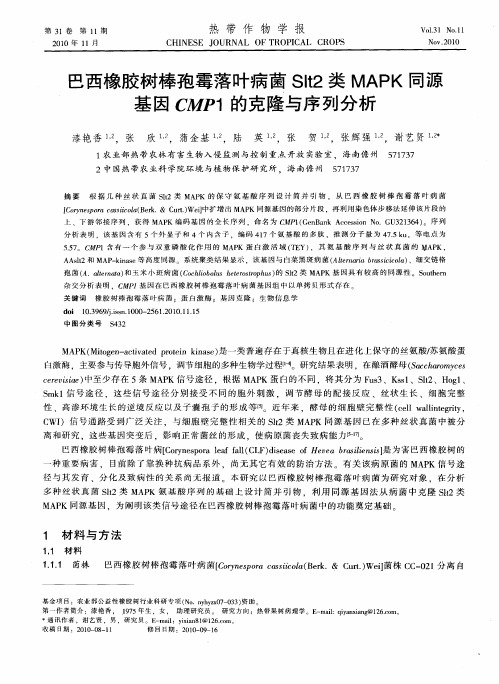
111 菌株 巴西橡 胶树 棒孢 霉 落 叶病 菌[0) .. c ,耽印00 csi oa B r.& C r ) i 株 C 一 2 分 离 自 , r asi l( ek c ut we】 . 菌 C01
基 金 项 目 :农 业 部 公 益 性 橡 胶 树 行 业科 研 专项 ( 0 yyx7 O 3 资 助 。 N .nh z0 一 3 )
一
种 重要 病 害 , 目前 除 了靠换 种 抗 病 品系 外 ,尚无其 它 有 效 的 防治 方法 。有关 该 病 原菌 的 MA K信号 途 P
径 与 其发 育 、分 化 及致 病 性 的关 系 尚无 报 道 。本 研 究 以 巴西橡 胶 树 棒孢 霉 落 叶病 菌 为研 究 对 象 .在分 析
中 图分 类号 ¥ 3 42
MA K Mi gn at a d Doen kn s ) P ( t e - ci t rti iae 是一类 普遍存 在 于真 核生 物且在进 化上 保守 的丝 氨酸/ o ve 苏氨 酸蛋
白激酶 ,主要参 与传导胞外信号 ,调节细胞 的多种 生物学过程
Байду номын сангаас
研 究结果 表明 .在酿酒 酵母 (ac ao ye S c hrm cs
c rv i ) ee ia 中至少存 在 5条 MA K信号 途径 ,根 据 MA K蛋 白的不 同 ,将其 分为 F s 、K s 、St 、H g 、 se P P u3 s1 l 2 o l Sk m l信 号途 径 ,这些 信 号 途 径 分 别接 受 不 同 的胞 外 刺 激 ,调节 酵 母 的配 接 反 应 、丝状 生 长 、细 胞 完 整 性 、高渗 环境 生 长 的逆境 反 应 以及 子囊 孢 子 的形 成 等【 5 1 。近年 来 ,酵母 的 细胞 壁 完整 性 (e a itgi , cl w lner v l l t C )信 号 通路 受 到广 泛 关 注 .与 细胞 壁 完 整性 相关 的 St WI l 2类 MA K 同源 基 因 已 在多 种 丝 状真 菌 中被 分 P 离和研 究 ,这些 基 因突 变后 ,影 响正 常菌 丝 的形成 .使 病原 菌丧 失致 病 能力[1 57 -] 巴西橡 胶树 棒孢 霉落 叶病 [oy ep r l ffl C F dsae 0 口 。baiess 为害 巴西 橡胶 树 的 C rn soa e al L )i s fHee rs ini 是 a ( e l 1
01-Introduction to Bioinformatics(生物信息学国外教程2010版)
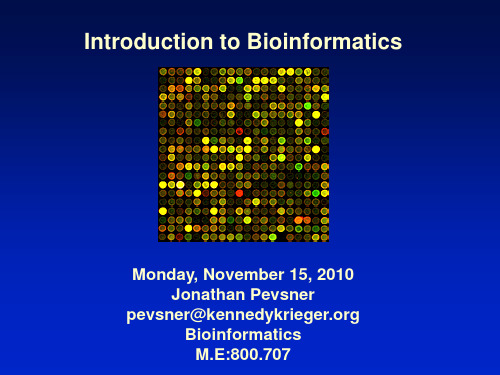
Grading
60% moodle quizzes (your top 6 out of 7 quizzes). Quizzes are taken at the moodle website, and are due one week after the relevant lecture. Special extended due date for quizzes due immediately after Thanksgiving and the New Year. 40% final exam Monday, January 10 (in class). Closed book, cumulative, no computer, short answer / multiple choice. Past exams will be made available ahead of time.
Outline for the course (all on Mondays)
1. Accessing information about DNA and proteins Nov. 15
2. Pairwise alignment
3. BLAST 4. Multiple sequence alignment
Literature references
You are encouraged to read original source articles (posted on moodle). They will enhance your understanding of the material. Readings are optional but recommended.
Nov. 22
真菌类过氧化物酶体增殖因子PEX11基因家族生物信息学研究
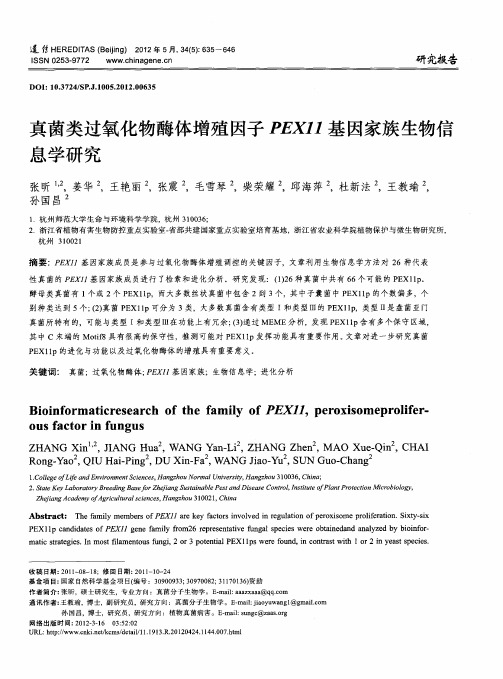
PE 1 p c n ia e fPE 1 g n a i r m2 e r s n ai e f n a p c e r b an d n n lz d b i i f r X a d d t s o X1 e e fm l fo 6 r p e e tt u g ls e i swe e o t i e a d a ay e y b o n o ・ l y v mai tae is I s l me t u u g , r3 p t n i l E 1 p r o n , n c n r s wi r2 i e s s e is t s tg e . n mo tf a n o sf n i 2 o o e ta X swe e f u d i o t t t 1 o n y a t p ce . c r i P l a h
收 稿 日期 : 0 l 0 — 8 2 1一 8 1;修 回 日期 : 0 1 0 2 2 1-1- 4
生物信息学参考书目
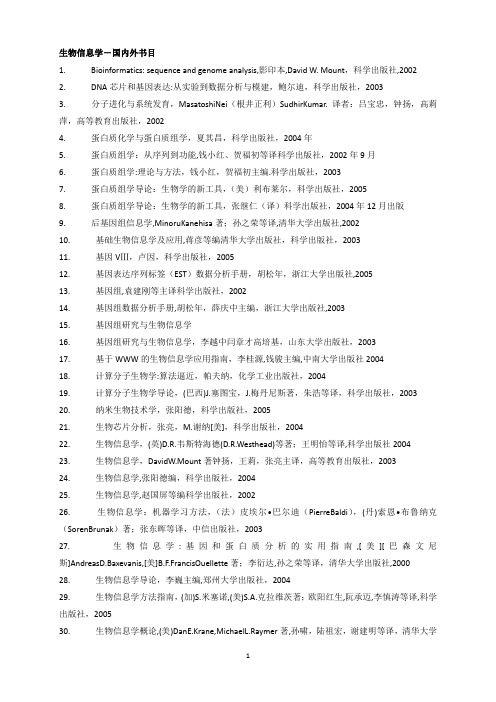
生物信息学-国内外书目1. Bioinformatics: sequence and genome analysis,影印本,David W. Mount,科学出版社,20022. DNA芯片和基因表达:从实验到数据分析与模建,鲍尔迪,科学出版社,20033. 分子进化与系统发育,MasatoshiNei(根井正利)SudhirKumar. 译者:吕宝忠,钟扬,高莉萍,高等教育出版社,20024. 蛋白质化学与蛋白质组学,夏其昌,科学出版社,2004年5. 蛋白质组学:从序列到功能,钱小红、贺福初等译科学出版社,2002年9月6. 蛋白质组学:理论与方法,钱小红,贺福初主编.科学出版社,20037. 蛋白质组学导论:生物学的新工具,(美)利布莱尔,科学出版社,20058. 蛋白质组学导论:生物学的新工具,张继仁(译)科学出版社,2004年12月出版9. 后基因组信息学,MinoruKanehisa著;孙之荣等译,清华大学出版社,200210. 基础生物信息学及应用,蒋彦等编清华大学出版社,科学出版社,200311. 基因VⅢ,卢因,科学出版社,200512. 基因表达序列标签(EST)数据分析手册,胡松年,浙江大学出版社,200513. 基因组,袁建刚等主译科学出版社,200214. 基因组数据分析手册,胡松年,薛庆中主编,浙江大学出版社,200315. 基因组研究与生物信息学16. 基因组研究与生物信息学,李越中闫章才高培基,山东大学出版社,200317. 基于WWW的生物信息学应用指南,李桂源,钱骏主编,中南大学出版社200418. 计算分子生物学:算法逼近,帕夫纳,化学工业出版社,200419. 计算分子生物学导论,(巴西)J.塞图宝,J.梅丹尼斯著,朱浩等译,科学出版社,200320. 纳米生物技术学,张阳德,科学出版社,200521. 生物芯片分析,张亮,M.谢纳[美],科学出版社,200422. 生物信息学,(英)D.R.韦斯特海德(D.R.Westhead)等著;王明怡等译,科学出版社200423. 生物信息学,DavidW.Mount著钟扬,王莉,张亮主译,高等教育出版社,200324. 生物信息学,张阳德编,科学出版社,200425. 生物信息学,赵国屏等编科学出版社,200226. 生物信息学:机器学习方法,(法)皮埃尔•巴尔迪(PierreBaldi),(丹)索恩•布鲁纳克(SorenBrunak)著;张东晖等译,中信出版社,200327. 生物信息学:基因和蛋白质分析的实用指南,[美][巴森文尼斯]AndreasD.Baxevanis,[美]B.F.FrancisOuellette著;李衍达,孙之荣等译,清华大学出版社,200028. 生物信息学导论,李巍主编,郑州大学出版社,200429. 生物信息学方法指南,(加)S.米塞诺,(美)S.A.克拉维茨著;欧阳红生,阮承迈,李慎涛等译,科学出版社,200530. 生物信息学概论,(美)DanE.Krane,MichaelL.Raymer著,孙啸,陆祖宏,谢建明等译,清华大学出版社200431. 生物信息学基础,孙啸,陆祖宏,谢建明编著,清华大学出版社200532. 生物信息学若干前沿问题的探讨:中国科协第81次青年科学家论坛论文集/黄德双等主编,中国科学技术大学出版社200433. 生物信息学手册,第2版,郝柏林等编,上海科学技术出版社,200234. 生物信息学网络资源与应用,黄韧等中山大学出版社,200335. 生物信息学中的计算机技术,(美)CyntbiaGibas,PerJambecks著;孙超等译中国电力出版社,200236. 生物序列分析,蛋白质和核酸的概率论模型[M].DurbinR,EddyS,KroghA,etal.北京:清华大学出版社,200237. 生物序列突变与比对的结构分析,沈世镒著,科学出版社200438. 探索基因组学、蛋白质组学和生物信息学(中译版)孙之荣主译,科学出版社,2004年8月出版39. 现代生物信息学理论与实践,李霞主编,科学出版社,2005年11月出版40. 药物基因组学——寻找个性化治疗,蒋华良、钟扬、陈国强、罗小民等译科学出版社,2005年7月出版41. 药物生物信息学,郑珩,王非,化学工业出版社,200442. 医学生物信息学,赵雨杰主编,人民军医出版社,200243. 遗传算法的基本理论与应用.李敏强,寇纪淞,林丹,李书全,科学出版社.2002年4月44. 遗传学:基因与基因组分析,哈特尔,科学出版社,200245. DNA Sequencing: From Experimental Methods to BioinformaticsAuthor(s): Luke Alphey46. Introduction to BioinformaticsAuthor(s): Teresa Attwood, David Parry-Smith47. Bioinformatics: The Machine Learning ApproachAuthor(s): P.Baldi and S. Brunak48. DNA Microarrays and Gene Expression: From Experiments to Data Analysis and Modeling Author(s): Pierre Baldi, G. Wesley Hatfield49. Bioinformatics for GeneticistsAuthor(s): Michael Barnes, Ian C Gray50. Bioinformatics: A Practical Guide to the Analysis of Genes and Proteins, Second EditionAuthor(s): Andreas D. Baxevanis and B. F. Francis Ouellette (Eds)51. Bioinformatics ComputingAuthor(s): Bryan P. Bergeron52. Genetics DatabasesAuthor(s): M. J. Bishop53. Structural BioinformaticsAuthor(s): Philip E. Bourne, Helge Weissig54. Computational Modeling of Genetic and Biochemical NetworksAuthor(s): James M. Bower and Hamid Bolouri55. Bioinformatics: A Biologist's Guide to Biocomputing and the InternetAuthor(s): Stuart M. Brown56. Discovering Genomics, Proteomics, and BioinformaticsAuthor(s): A. Malcolm Campbell, Laurie J. Heyer57. Bioinformatics for DummiesAuthor(s): Jean-Michel Claverie and Cedric Notredame58. Computational Molecular Biology: An IntroductionAuthor(s): Peter Clote, Rolf Backofen59. Nonlinear Estimation and ClassificationAuthor(s): D.D. Denison, M.H. Hansen, C.C. Holmes, B. Mallick & B. Yu (Eds.)60.Author(s): Richard Durbin, Sean R. Eddy, Anders Krogh, Graeme Mitchison61. Genomic Perl: From Bioinformatics Basics to Working CodeAuthor(s): Rex A. Dwyer62. Protein Bioinformatics: An Algorithmic Approach to Sequence and Structure Analysis Author(s): Ingvar Eidhammer, Inge Jonassen, William R.T. Taylor63. Computational Cell BiologyAuthor(s): Christopher P. Fall, Eric S. Marland, John M. Wagner and John J. Tyson, Editors64. Evolutionary Computation in BioinformaticsAuthor(s): Gary B. Fogel, David W. Corne65. Developing Bioinformatics Computer SkillsAuthor(s): Cynthia Gibas, Per Jambeck66. Statistical Methods in Bioinformatics: An IntroductionAuthor(s): Gregory R. Grant, Warren J. Ewens67. Algorithms on Strings, Trees and SequencesAuthor(s): Dan Gusfield68. Bioinformatics : Sequence, Structure, and Databanks : A Practical ApproachAuthor(s): Des Higgins (Editor), Willie Taylor (Editor)69. Post-genome InformaticsAuthor(s): Minoru Kanehisa70. Foundations of Systems BiologyAuthor(s): Hiroaki Kitano71. Guide to Analysis of DNA Microarray Data72. Microarrays for an Integrative GenomicsAuthor(s): Isaac S. Kohane, Alvin Kho, Atul J. Butte73. BLASTAuthor(s): Ian Korf, Mark Yandell, Joseph Bedell74. Hidden Markov Models for BioinformaticsAuthor(s): Timo Koski75. Fundamental Concepts of BioinformaticsAuthor(s): Dan E. Krane, Michael L. Raymer76. Advances in Molecular BioinformaticsAuthor(s): Steffen Schulze-Kremer (Editor)77. Molecular Bioinformatics: Algorithms and ApplicationsAuthor(s): Steffen Schulze-Kremer78. Computational BiologyAuthor(s): Lecture Notes in Computer Science, Vol. 206679. Analysis of Microarray Gene Expression DatasAuthor(s): Mei-Ling Ting Lee80. Bioinformatics: From Genomes to DrugsAuthor(s): Thomas Lengauer81. Sequence Analysis in a Nutshell: A Guide to Common Tools and Databases Author(s): Darryl LeÛn, Scott Markel82. Introduction to BioinformaticsAuthor(s): Arthur M. Lesk83. Computational Molecular BiologyAuthor(s): J. Leszczynski84. Bioinformatics: Databases and SystemsAuthor(s): Stanley Letovsky (Editor)85. Computational Cell BiologyAuthor(s): Eric Marland, John Wagner, John Tyson86. Bioinformatics and Genome AnalysisAuthor(s): H.W. Mewes, B. Weiss, H. Seidel87. Bioinformatics: Methods and ProtocolsAuthor(s): Stephen Misener (Editor), Stephen A. Krawetz (Editor)88. Bioinformatics: Sequence and Genome AnalysisAuthor(s): David W. Mount89. Bioinformatics: Genes, proteins and computersAuthor(s): C.A. Orengo, D.T. Jones and J.M. Thornton90. Mathematics of Genome Analysis91. Computational Molecular Biology: An Algorithmic ApproachAuthor(s): Pavel A. Pevzner92. Bioinformatics Basics Applications in Biological Science and MedicineAuthor(s): Hooman H. Rashidi, Lukas K. Buehler93. The Phylogenetic Handbook: A Practical Approach to DNA and Protein PhylogenyEdited by Marco Salemi, Anne-Mieke Vandamme94. Computational Methods in Molecular BiologyAuthor(s): S.L. Salzberg, D.B. Searls, S. Kasif95. Comparative Genomics: Empirical and Analytical Approaches to Gene Order Dynamics, Map Alignment and the Evolution of Gene FamiliesAuthor(s): David Sankoff, Joseph H. Nadeau96. Molecular Modeling and Simulation: An Interdisciplinary GuideAuthor(s): Tamar Schlick97. Bioinformatics: From Nucleic Acids and Proteins to Cell MetabolismAuthor(s): Dietmar Schomburg (Editor), Uta Lessel (Editor)98. Introduction to Computational Molecular BiologyAuthor(s): Joao Carlos Setubal, Joao Meidanis, Jooao Carlos Setubal99. Likelihood, Bayesian and MCMC Methods in Quantitative GeneticsAuthor(s): Daniel Sorensen, Daniel Gianola100. Microarray BioinformaticsAuthor(s): Dov Stekel101. Protein Structure Prediction - A Practical ApproachAuthor(s): Michael J. E. Sternberg102. Beginning Perl for BioinformaticsAuthor(s): James Tisdall103. Pathway Analysis and Optimization in Metabolic Engineering Author(s): Néstor V. Torres, Eberhard O. Voit104. Gene Regulation and Metabolism: Post-Genomic Computational ApproachesAuthor(s): Julio Collado-Vides and Ralf Hofestadt105. Computational Analysis of Biochemical Systems A Practical Guide for Biochemists and Molecular Biologists Author(s): Eberhard O. Voit106. Pattern Discovery in Biomolecular Data - Tools, Techniques, and ApplicationsAuthor(s): Jason T. L. Wang, Bruce A. Shapiro, and Dennis Shasha107. Introduction to Computational Biology: Maps, Sequences and GenomesAuthor(s): Michael S Waterman108. Instant Notes BioinformaticsAuthor(s): D.R. Westhead, J. H. Parish, R.M. TwymanAuthor(s): Limsoon Wong110. Neural Networks and Genome InformaticsAuthor(s): Cathy H. Wu, Jerry W. McLarty111. Intelligent Bioinformatics: The Application of Artificial Intelligence Techniques to Bioinformatics ProblemsAuthor(s): Edward Keedwell, Ajit Narayanan112. Jonathan Pevsner,Bioinformatics and Functional Genomics,John Wiley & Sons, Inc,2003。
- 1、下载文档前请自行甄别文档内容的完整性,平台不提供额外的编辑、内容补充、找答案等附加服务。
- 2、"仅部分预览"的文档,不可在线预览部分如存在完整性等问题,可反馈申请退款(可完整预览的文档不适用该条件!)。
- 3、如文档侵犯您的权益,请联系客服反馈,我们会尽快为您处理(人工客服工作时间:9:00-18:30)。
Page 700
Sequencing the S. cerevisiae genome
Génolevure project
Euascomycetae
Neurospora
Loculoascomycetae
Laboulbeniomycetae parasites of insects
Basidiomycota rusts, smuts, mushrooms
Chytridiomycota Allomyces
The genome was sequenced by a highly cooperative consortium in the early 1990s, chromosome by chromosome (the whole genome shotgun approach was not used).
Monday Nov. 23: Eukaryotic genomes (Chapter 18) Wednesday Nov. 25: Eukaryotic genomes (Chapter 18) Next Friday: Thanksgiving
Monday Nov. 30: Hongkai Ji Wednesday December 2: Al Scott Friday: lab on eukaryotes
About 70,000 fungal species have been described (as of 1995), but 1.5 million species may exist.
Four phyla:
Ascomycota
yeasts, truffles, lichens
Hemiascomycetae
This involved 600 researchers in > 100 laboratories.
--Physical map created for all XVI chromosomes --Library of 10 kb inserts constructed in phage --The inserts were assembled into contigs
Page 701
Page 703
The EBI website offers a variety of proteome analysis tools, such as this summary of protein length distribution in S. cerevisiae.
Introns in ORFs:Байду номын сангаас220
Introns in UTRs: 15
Intact Ty elements: 52
tRNA genes:
275
snRNA genes:
40
Page 702
Features of the S. cerevisiae genome
A notable feature of the genome is its high gene density (about one gene every 2 kilobases). Most bacteria have about one gene per kb, but most eukaryotes have a much sparser gene density.
First species domesticated by humans
Called baker’s yeast (or brewer’s yeast)
Ferments glucose to ethanol and carbon dioxide
Model organism for studies of biochemistry, genetics, molecular and cell biology
These images and materials may not be used without permission.
Visit
Schedule
Monday: Yeast functional genomics (Jef Boeke) Wednesday: Fungi (Chapter 17) Friday: lab on yeast (start drafting your project!)
The sequence released in 1996, and published in 1997 (Goffeau et al., 1996; Mewes et al., 1997)
Page 701
Features of the S. cerevisiae genome
Sequenced length: 12,068 kb = 12,068,000 base pairs
Zygomycota
feed on decaying vegetation
Box 17-1 Page 699
Alternate classification of fungi
Outline of today’s lecture
Description and classification of fungi The Saccharomyces cerevisiae genome
Sequencing Features of the genome Yeast chromosomes Duplication of the yeast genome Functional genomics in yeast Comparative genomics of fungi
Introduction to fungi: phylogeny
Several criteria may be applied to decide if ORFs are authentic protein-coding genes:
Eukaryotic Genomes: Fungi
Wednesday, November 18, 2009
Genomics 260.605.01 J. Pevsner pevsner@
Copyright notice
Many of the images in this powerpoint presentation are from Bioinformatics and Functional Genomics by J Pevsner, copyright © 2009 by Wiley-Blackwell.
Length of repeats: 1,321 kb
Total length:
13,389 kb (~ 13 Mb)
Open reading frames (ORFs): Questionable ORFs (qORFs): Hypothetical proteins:
6,275 (see updates below) 390 5,885
Also, only 4% of S. cerevisiae genes are interrupted by introns. By contrast, 40% of genes from the fungus Schizosaccharomyces pombe have introns.
What are the most common protein families and protein domains? You can see the answer at EBI’s website: /proteome/
Fig. 17.1 Page 698
Classification of fungi
About 70,000 fungal species have been described (as of 1995), but 1.5 million species may exist.
Four phyla: Ascomycota
/proteome/
Fig. 17.3 Page 703
ORFs in the S. cerevisiae genome
How are ORFs defined? In the initial genome analysis, an ORF was defined as >100 codons (thus specifying a protein of ~11 kilodaltons).
Fungi are eukaryotic organisms that can be filamentous (e.g. molds) or unicellular (e.g. the yeast Saccharomyces cerevisiae).
Most fungi are aerobic (but S. cerevisiae can grow anaerobically). Fungi have major roles in the ecosystem in degrading organic waste. They have important roles in fermentation, including the manufacture of steroids and penicillin.
yeasts, truffles, lichens
Basidiomycota rusts, smuts, mushrooms
Chytridiomycota Allomyces
